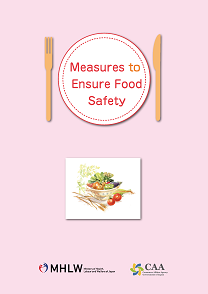健康・医療About Us
In the current framework in Japan, risk assessment body is completely separated from risk management body, and is placed into the Food Safety Commission (FSC) established in the Cabinet Office under the Food Safety Basic Act.
Risk management is conducted by three agencies; the Ministry of Health, Labour and Welfare (MHLW), the Ministry of Agriculture, Forestry and Fisheries (MAFF) and the Consumer Affairs Agency (CAA). They have responsibilities for developing necessary measures and regulations based on risk assessment results.
Risk communication is done by all these agencies.
Ministry of Health, Labour and Welfare (MHLW)
Under the Food Sanitation Act and other related acts, the CAA lays down regulations and set food safety standards for foods, food additives, pesticide and veterinary drug residues in foods, and food utensils, containers/packaging and so on, as preventative measures and the MHLW prohibits the distribution of harmful foods.
The MHLW works closely with other governmental agencies and local governments, and ensures proper implementation of food safety measures.
Regional Bureaus of Health and Welfare
Regional Bureaus of Health and Welfare are located in seven regions across Japan; Hokkaido, Tohoku, Kanto-Shinetsu, Tokai-Hokuriku, Kinki, Chugoku-Shikoku, and Kyushu.
They register private laboratories as“ Registered Laboratories” which operate food inspection business in compliance with GLP (Good Laboratory Practice) under the Food Sanitation Act.
Quarantine Stations
There are 32 quarantine stations located at international seaports and airports.
・Document examination of import notification
・Inspect and monitor imported foods and related products
・Guide importers on practical procedures of food import
Cooperation with Local Governments
There are 47 prefectural governments, 87 municipalities with public health centers, and 23 special wards of Tokyo Metropolis.
・Inspect local restaurants, food manufacturers and distributors. Investigate the cause in case of an outbreak of food poisoning.
・Set hygiene standards based on relevant ordinances.
・Issuance of business licenses for specific type of food business manufactures. Suspend or revoke its licenses upon violation.
・Formulate inspection and guidance plan for foods distributing in domestic marketplace. Activities according to the plan are executed by public health centers.




